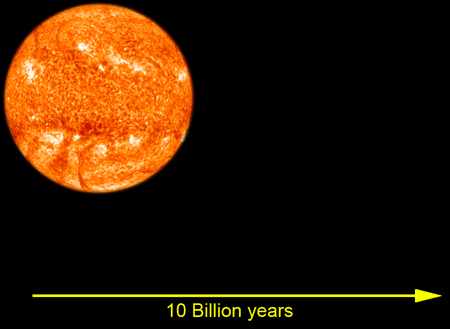Star Life Cycles - Large Stars
Stars and NebulaeIndex
Interstellar Clouds Questions Credits Links Michael Gallagher August 2002 July 2007 |

Sun-sized stars burn their fuel slowly and have lengthy lives. If a larger amount of gas is available, larger stars can form. Larger stars have higher internal pressures and temperatures and higher rates of nuclear fusion. They radiate intense hot white/blue light. They also have strong stellar winds that transport significant amounts of material back to the interstellar medium. Although they contain much more material than the Sun, they exhaust their fuel earlier. When all fusible hydrogen is gone, fusion of other elements begins and they expand into Red Giants. When all fuel is exhausted, their cores collapse. An enormous supernova explosion hurls a massive cloud of dust and gas into surrounding space. If the core is sufficently massive, its collapse produces a neutron star, an object more massive than the sun nut which occupies a volume only 20 kilometres or so across. These objects have often have intense magnetic fields, spin quickly and emit intense pulses of radiation. They are then called Pulsars. Large Star Details Mass: 9 to 40 Suns Surface Temperature: 10,000° to 20,000° K Lifetime: A few hundred million years. End points*: Remnant core mass less than 1.4 Suns: Planetary nebula and white dwarf Remnant core mass greater than 1.4 Suns: Supernova explosion - debris cloud and core collapse to a neutron star
* The relation between a star's inital mass and its end point is imperfectly understood.
A star that joins the main sequence as a 10 solar mass can lose as much of 75% of its mass
before it reaches its core collapse stage. More material is lost in the core collapse explosion itself.
A core of around 2.5 solar masses is thought to be necessary for collapse to proceed to a neutron star.
Ligher cores form white dwarfs.
|
